Top 18 Succulent Plants to Grow in 2024: Add Effortless Elegance to Your Home
- April 23, 2024
- 0 comment
Discover the Top 18 Succulent Plants to Grow in 2024 and effortlessly bring elegance and vibrant life into your home with these easy-care varieties. Succulents are renowned for their low maintenance and diverse aesthetics, making them ideal for enhancing any home environment. This selection of the top 18 easy-care succulents for 2024 ensures that you can add effortless elegance and vibrant life to your living spaces.
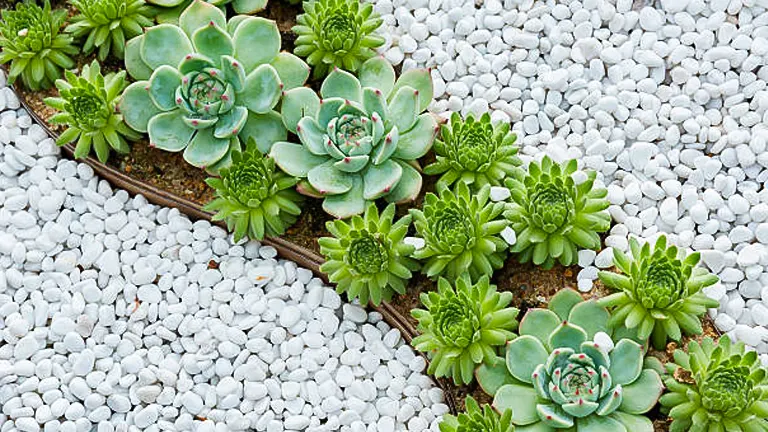
Whether you’re looking to decorate a sunny windowsill or a shaded corner, these plants are perfect for busy individuals seeking beauty without the hassle. Explore our curated picks and transform your indoor or outdoor areas with these striking and resilient plants.
List of Top 18 Succulent Plants to Grow in 2024
- Echeveria ‘Lola’
- Senecio Radicans (String of Bananas)
- Haworthia Cooperi
- Sempervivum Tectorum (Hens and Chicks)
- Crassula Ovata (Jade Plant)
- Aeonium ‘Zwartkop’
- Sedum Morganianum (Burro’s Tail)
- Opuntia Microdasys (Bunny Ears Cactus)
- Kalanchoe Blossfeldiana (Flaming Katy)
- Portulacaria Afra (Elephant Bush)
- Graptopetalum Paraguayense (Ghost Plant)
- Dudleya Brittonii (Giant Chalk Dudleya)
- Faucaria Tigrina (Tiger Jaws)
- Sedum Rubrotinctum (Jelly Bean Plant)
- Agave Victoriae-Reginae (Queen Victoria Agave)
- Cotyledon Orbiculata (Pig’s Ear)
- Pachyphytum Oviferum (Moonstones)
- Xerographica (Tillandsia Xerographica)
Understanding Succulent Plants
What Are Succulents?
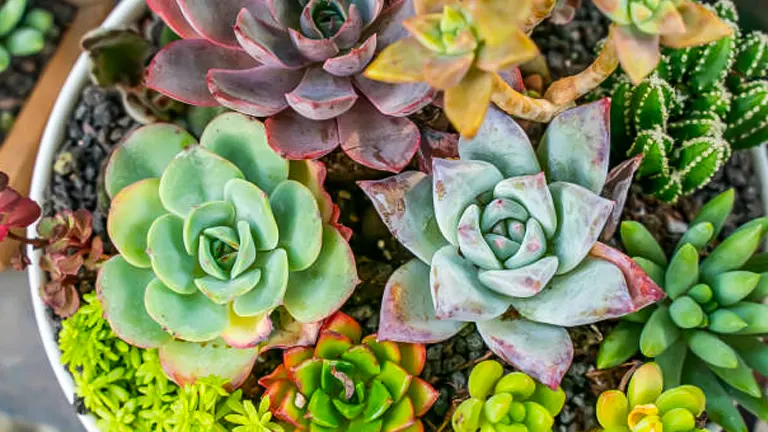
Succulents are a group of plants characterized by their thick, fleshy tissues which are adapted to store water. This unique feature allows them to thrive in arid conditions and makes them ideal for indoor settings where other plants might not survive. Beyond their drought tolerance, succulents come in an array of shapes, sizes, and colors, providing endless possibilities for decoration.
Benefits of Growing Succulents
Environmental Benefits:
- Air Purification: Succulents help cleanse the air by removing toxins and improving humidity. This can enhance respiratory health and provide a fresher, more pleasant home environment.
- Low Water Usage: Their ability to store water in their leaves allows them to require less frequent watering than typical houseplants, which is beneficial for water conservation efforts.
Health and Wellness Benefits:
- Stress Reduction: Studies have shown that having plants in the home can decrease stress levels. Succulents, with their easy care and serene appearance, can create a calming atmosphere in any room.
- Aesthetic Appeal: Incorporating succulents into home decor not only brings beauty and a natural element indoors but can also improve mood and creativity.
Choosing the Right Succulents
Criteria for Selection
When selecting succulents for indoor cultivation, consider the following key factors to ensure they not only survive but thrive:
- Light Requirements: Succulents prefer bright, indirect light. A spot near a window that receives several hours of sunlight is ideal, but be cautious of direct afternoon sun, which can scorch some species.
- Watering Needs: Over-watering is a common mistake with succulents. These plants require a ‘soak and dry’ method, which means the soil should be completely dried out before re-watering.
- Temperature and Humidity: Most succulents prefer temperate climates with low humidity. Indoor environments should be kept at temperatures between 60 to 80 degrees Fahrenheit.
Pots and Planting Medium
Choosing the right pot and soil is crucial for the health of succulents:
- Type of Pots: Drainage is key. Opt for pots with drainage holes and materials like terracotta or ceramic that allow the soil to dry out efficiently.
- Planting Medium: Avoid using regular garden soil. Succulents need a well-draining mixture, typically a cactus mix supplemented with sand, perlite, or pumice for increased aeration.
Top 18 Succulents to Grow in 2024
1. Echeveria ‘Lola’
Echeveria ‘Lola’ is admired for its pale lavender leaves that form a tight, rounded rosette resembling a sculpted wax flower. Its leaves have a chalky finish that enhances their delicate pastel hue, making it an attractive option for minimalist decor schemes. Echeveria ‘Lola’ is particularly robust against dry conditions and can thrive with infrequent watering, making it a popular choice for both beginner and experienced succulent growers.
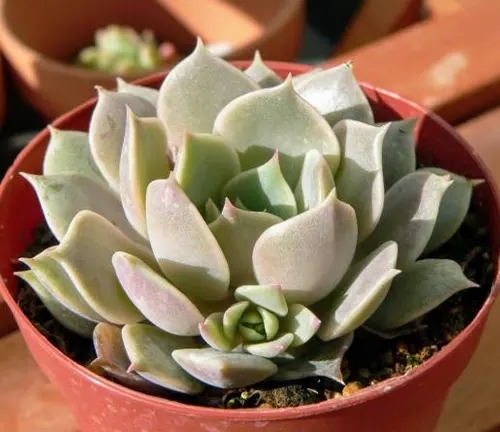
Planting and Care:
- Best Time to Plant: Early spring for optimal growth as light levels increase.
- Watering: Water every other week, allowing soil to completely dry between sessions.
- Light: Prefers bright, indirect light; direct sun may burn the leaves.
- Soil: Use a porous, well-draining cactus or succulent mix.
- Temperature: Keep above 50°F (10°C); not frost-hardy.
- Fertilization: Apply a diluted low-nitrogen fertilizer monthly during spring and summer.
2. Senecio Radicans (String of Bananas)
Characterized by its cascading stems with teardrop-shaped, glossy green leaves, Senecio Radicans adds dynamic visual interest with its dense and lush appearance. This succulent is not only easy to care for but also fast-growing, which makes it ideal for hanging baskets where its vines can drape gracefully. It’s resilient to pests and diseases, which ensures it remains vibrant with minimal effort.
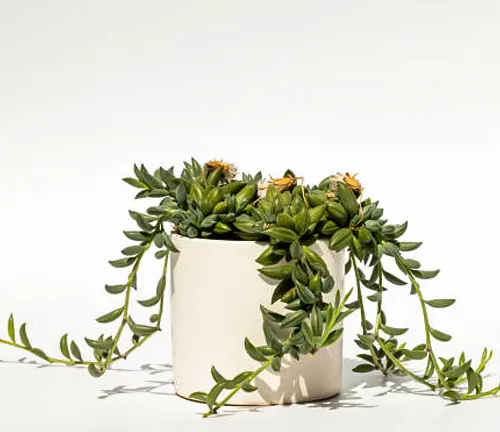
Planting and Care:
- Best Time to Plant: Plant in spring to leverage the growing season.
- Watering: Let soil dry out before watering deeply.
- Light: Bright, indirect sunlight preferred, though it can tolerate some direct sun.
- Soil: A light, airy, well-draining potting mix.
- Additional Care: Trim back vines to encourage thicker growth.
- Propagation: Propagate from stem cuttings in either water or directly in soil.
3. Haworthia Cooperi
This small, rosette-forming succulent is known for its see-through, bubble-like leaves that shimmer in the light. Haworthia Cooperi is perfect for low-light conditions where other succulents might struggle. It grows slowly and remains compact, making it ideal for small spaces such as shelves and office desks. The translucent leaves are particularly striking when backlit by natural light, highlighting their intricate details.
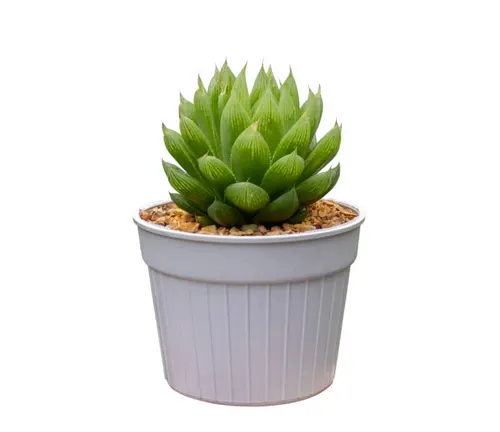
Planting and Care:
- Best Time to Plant: Early to mid-spring.
- Watering: Water moderately in the growing season, less during winter.
- Light: Prefers shade or semi-shade; too much light can cause leaf scorch.
- Soil: Well-draining soil with plenty of organic material.
- Temperature: Does best in average room temperatures from 60 to 80°F (16 to 27°C).
- Additional Care: This plant is more sensitive to over-watering than most succulents, so ensure good drainage.
4. Sempervivum Tectorum (Hens and Chicks)
Sempervivum Tectorum, commonly known as Hens and Chicks, features a central “hen” rosette surrounded by clusters of “chicks” — smaller rosettes that form from the main plant. This hardy succulent is perfect for ground covers or rock gardens due to its drought resistance and ability to thrive in poor soil. The plant’s ability to propagate itself makes it a sustainable choice for expansive green areas.

Planting and Care:
- Best Time to Plant: Early spring.
- Watering: Water sparingly; only when the soil is completely dry.
- Light: Full sun to partial shade.
- Soil: Poor, well-draining soil; often thrives in rocky gardens.
- Temperature: Hardy to below freezing.
- Additional Care: Remove dead rosettes to promote health and appearance.
5. Crassula Ovata (Jade Plant)
The Jade Plant is a popular succulent due to its woody stems and oval-shaped, glossy green leaves that sometimes have a red tinge on the edges. Its thick leaves and robust nature make it an excellent indoor plant, as it can store water very efficiently and requires little care. The Jade Plant is also known for bringing financial luck and prosperity into the home, according to folklore.
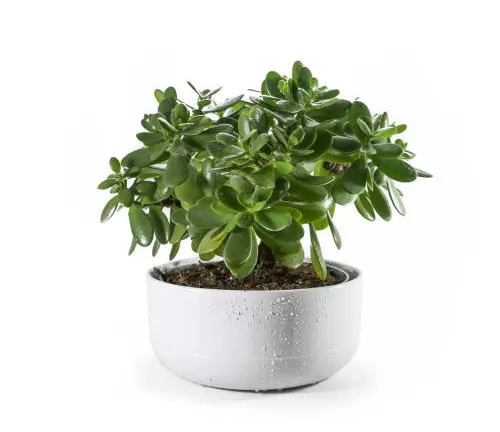
Planting and Care:
- Best Time to Plant: Spring or early summer.
- Watering: Water every 2-3 weeks, depending on humidity levels; reduce in winter.
- Light: Bright, indirect light or partial sun.
- Soil: A well-draining potting mix is essential.
- Temperature: Prefers temperatures from 65°F to 75°F (18°C to 24°C).
- Fertilization: Feed with a controlled-release fertilizer at the beginning of the season or weekly with a weak liquid solution during active growth.
6. Aeonium ‘Zwartkop’
Aeonium ‘Zwartkop’, also known as Black Rose, boasts magnificent rosettes of burgundy-black leaves at the ends of its branch-like stems. Its dramatic appearance makes it a striking feature in any succulent collection. This plant prefers cooler and wetter conditions than most succulents, which makes it well-suited to outdoor growth in temperate climates.
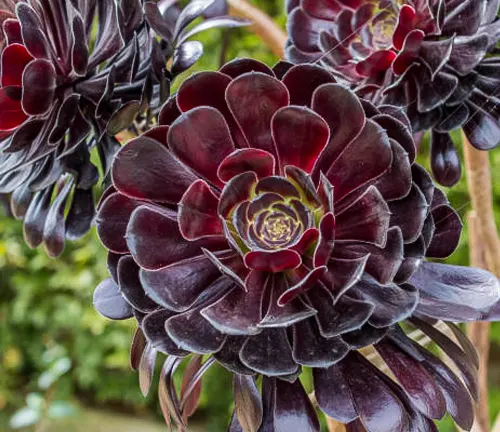
Planting and Care:
- Best Time to Plant: Late winter to early spring.
- Watering: Allow soil to dry out between waterings, increase frequency with heat.
- Light: Full sun for best color development.
- Soil: Well-draining soil; add sand or gravel to improve drainage if necessary.
- Temperature: Cooler than average temperatures for succulents; protect from frost.
- Additional Care: Aeoniums go dormant in summer; reduce watering during this period.
7. Sedum Morganianum (Burro’s Tail)
Sedum Morganianum, or Burro’s Tail, features fleshy leaves that grow on long, hanging stems that can reach several feet in length. Its cascading nature makes it ideal for hanging baskets, and its vibrant green color provides a stunning visual contrast in any setting. This succulent is particularly forgiving and is capable of thriving under a wide range of conditions.
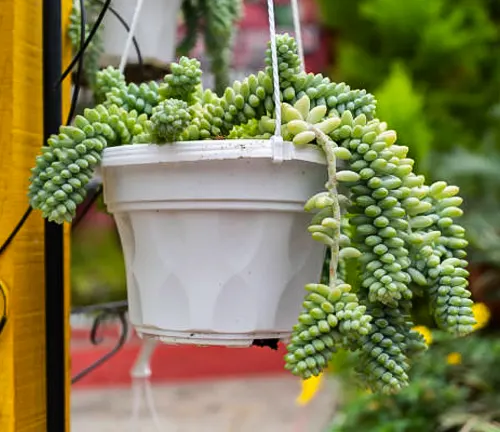
Planting and Care:
- Best Time to Plant: Spring.
- Watering: Water moderately in the growing season, but allow the soil to dry completely between watering sessions.
- Light: Bright indirect light; too much direct sunlight can cause burns.
- Soil: Use a fast-draining succulent mix, enriched with perlite to enhance drainage.
- Temperature: Keep at room temperature; avoid drafts and sudden temperature changes.
- Additional Care: Handle with care as the stems can be quite delicate and leaves may drop off if disturbed.
8. Opuntia Microdasys (Bunny Ears Cactus)
Opuntia Microdasys, also known as Bunny Ears Cactus, is distinguished by its pad-like stems that resemble the ears of a rabbit. This cactus is favored for its quirky shape and ease of care, making it a popular choice for both indoor and outdoor succulent gardens. Unlike many cacti, it lacks traditional spines but has numerous glochids (tiny barbs) that can detach easily upon touch.
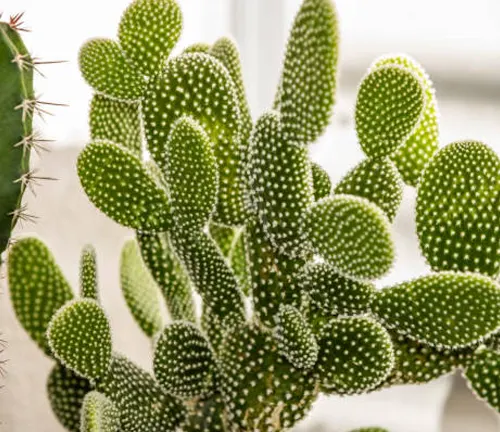
Planting and Care:
- Best Time to Plant: Early spring.
- Watering: Water infrequently; allow the soil to dry thoroughly between waterings.
- Light: Needs bright light, with some direct sunlight to thrive.
- Soil: A sandy, well-draining cactus mix is ideal.
- Temperature: Prefers warm conditions but needs to be protected from extreme heat and frost.
- Additional Care: Wear gloves when handling to avoid glochids. Trim pads to encourage branching and manage growth.
9. Kalanchoe Blossfeldiana (Flaming Katy)
Kalanchoe Blossfeldiana, commonly referred to as Flaming Katy, is a vibrant succulent that boasts thick, rich green leaves and bright flower clusters that appear in winter to spring. This plant is particularly known for its long-lasting bloom and minimal care requirements, making it a splendid addition to any succulent display.

Planting and Care:
- Best Time to Plant: Spring.
- Watering: Allow the soil to become dry between waterings; reduce watering in the winter.
- Light: Bright, indirect light is perfect. Avoid direct summer sun.
- Soil: Use a well-draining potting mix, ideally formulated for cacti and succulents.
- Temperature: Keep between 60°F and 85°F (16°C to 29°C).
- Fertilization: Feed with a balanced, controlled-release fertilizer every few months during the growing season.
10. Portulacaria Afra (Elephant Bush)
Portulacaria Afra, or Elephant Bush, is a robust succulent known for its thick, woody stems and small, glossy green leaves. Often used in bonsai, this plant can handle a bit of neglect, making it a durable choice for beginners. It’s also admired for its ability to absorb high amounts of carbon dioxide, purifying indoor air more efficiently than many other plants.
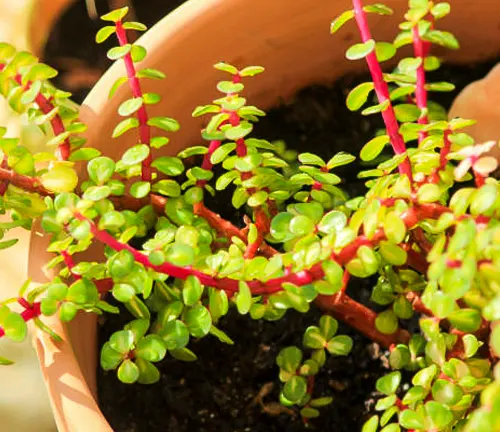
Planting and Care:
- Best Time to Plant: Spring to early summer.
- Watering: Water deeply but infrequently, allowing the soil to dry out completely between waterings.
- Light: Prefers full sun to partial shade.
- Soil: Any well-draining soil will do.
- Temperature: Ideal temperatures are between 60°F and 75°F (16°C to 24°C), but it can tolerate colder weather down to about 50°F (10°C) without issue.
- Additional Care: Pruning is recommended to keep its growth in check and to maintain its shape.
11. Graptopetalum Paraguayense (Ghost Plant)
Graptopetalum Paraguayense, known as the Ghost Plant, has a fascinating color palette that shifts from blue-gray to pinkish-yellow under different light exposures. Its rosettes are star-shaped and can spread out as ground cover or trail beautifully from containers. This plant is not only alluring in appearance but also extremely forgiving and adaptable.
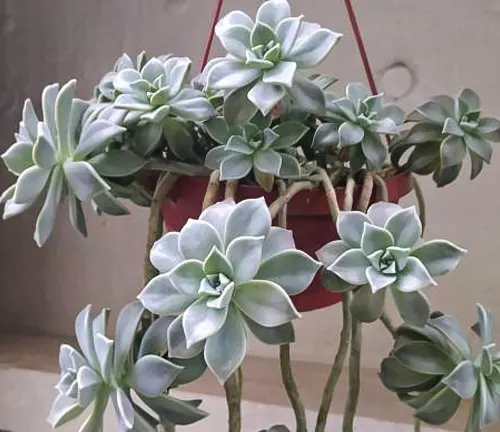
Planting and Care:
- Best Time to Plant: Spring.
- Watering: Water moderately during the growing season and sparingly in winter.
- Light: Full sun to partial shade; more sun deepens the colors.
- Soil: A well-draining mix suited for succulents; adding perlite or sand improves drainage.
- Temperature: Keep above 25°F (-4°C); it’s not as cold-hardy as some other succulents.
- Additional Care: This succulent is particularly drought-resistant; however, occasional watering during dry months will encourage more vibrant growth.
12. Dudleya Brittonii (Giant Chalk Dudleya)
Dudleya Brittonii, known as Giant Chalk Dudleya, features stunning rosettes of silvery white leaves that can add a surreal, sculptural element to any succulent garden. This plant’s waxy, powdery coating helps it reflect sunlight and conserve water, making it an excellent choice for sunny, dry locations.
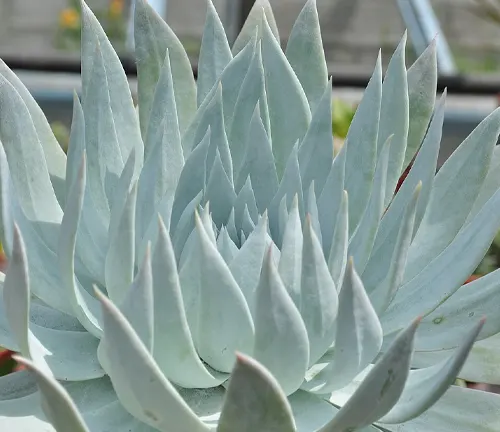
Planting and Care:
- Best Time to Plant: Spring, when cooler temperatures help them establish without stress.
- Watering: Minimal; water once a month or less frequently, depending on the dryness of the environment.
- Light: Prefers full sun but can tolerate partial shade.
- Soil: Needs well-draining, gritty soil; poor soil quality generally suffices.
- Temperature: Keep at 40°F (4°C) to 85°F (29°C). It’s frost-resistant but should be protected from severe winter wetness.
- Additional Care: Avoid physical contact as much as possible to not disturb the powdery bloom that protects its leaves.
13. Faucaria Tigrina (Tiger Jaws)
Faucaria Tigrina, or Tiger Jaws, earns its name from the tooth-like projections on the edges of its leaves which resemble a feline’s jaws. This succulent is not only fascinating in form but also blooms bright yellow flowers that add a cheerful splash of color when in season.
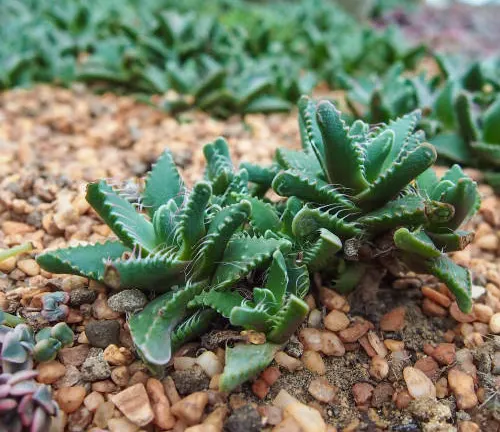
Planting and Care:
- Best Time to Plant: Spring or autumn.
- Watering: Water moderately in the active growth season, less during dormancy.
- Light: Full sun to partial shade is ideal to encourage flowering.
- Soil: Use a well-draining sandy soil mix to mimic its natural sandy habitat.
- Temperature: Prefers cooler temperatures, especially at night.
- Fertilization: Apply a cactus fertilizer sparingly during the growing season to support its growth and blooming.
14. Sedum Rubrotinctum (Jelly Bean Plant)
Sedum Rubrotinctum, commonly known as Jelly Bean Plant, features chubby leaves that resemble jelly beans, especially attractive when they turn red in full sun. This plant is extremely easy to grow and care for, making it a perfect beginner’s choice. It’s robust and adaptable, ideal for neglectful gardeners.
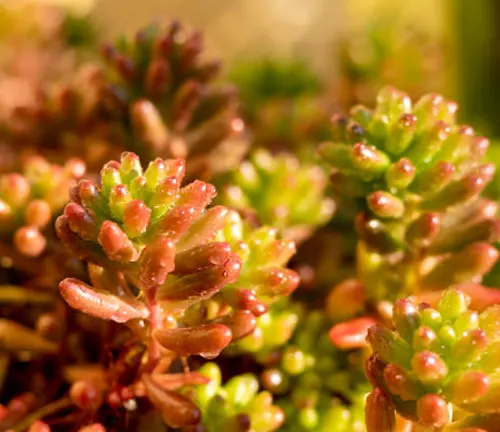
Planting and Care:
- Best Time to Plant: Spring.
- Watering: Allow soil to dry between waterings; more frequent water in hotter months, less in winter.
- Light: Full sun to develop the red coloration of the leaves, partial shade to protect from scorching.
- Soil: Loose, well-draining soil.
- Temperature: Keep above freezing; prefers temperatures between 60°F and 75°F (15°C to 24°C).
- Additional Care: Can be easily propagated from leaves, which take root readily in soil.
15. Agave Victoriae-Reginae (Queen Victoria Agave)
Agave Victoriae-Reginae, known as Queen Victoria Agave, is prized for its striking, compact form and neat rows of white-rimmed, tight green leaves. This slow-growing plant forms a sculptural rosette that can serve as a focal point in any succulent collection. It is particularly drought-tolerant, requiring very minimal watering.
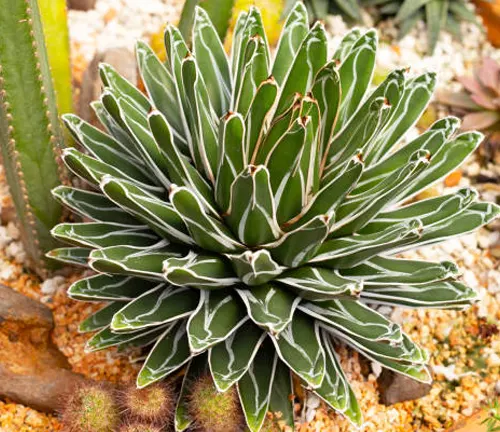
Planting and Care:
- Best Time to Plant: Spring.
- Watering: Very infrequently; ensure the soil is completely dry between waterings.
- Light: Full sun to partial shade.
- Soil: Very well-draining, rocky or sandy soil.
- Temperature: Frost resistant but best kept above 30°F (-1°C).
- Additional Care: This agave rarely needs repotting and benefits from being slightly root-bound for better stability and growth.
16. Cotyledon Orbiculata (Pig’s Ear)
Cotyledon Orbiculata, commonly referred to as Pig’s Ear, is noted for its thick, oval-shaped leaves that are green with a hint of red along the margins. This succulent’s distinct leaves not only add a unique texture to garden compositions but also thrive with minimal attention, making it suitable for gardeners of all skill levels.
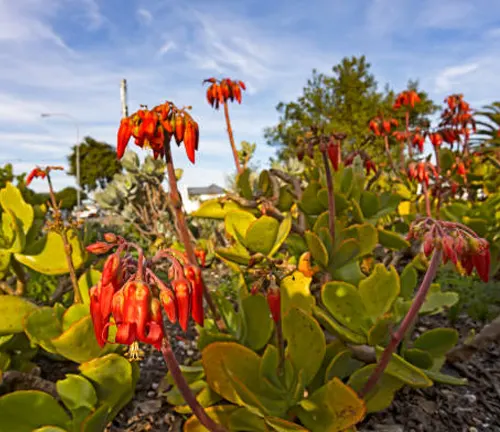
Planting and Care:
- Best Time to Plant: Early spring.
- Watering: Water sparingly, only when the soil is completely dry.
- Light: Full sun to partial shade, with light shade preferred in hotter climates to prevent leaf scorch.
- Soil: Well-draining soil mix, ideally with added gravel or sand for improved drainage.
- Temperature: Tolerates a minimum of 30°F (-1°C); provide protection from frost to avoid damage.
- Additional Care: The red tips of the leaves can intensify with more exposure to sunlight, enhancing the plant’s aesthetic appeal.
17. Pachyphytum Oviferum (Moonstones)
Pachyphytum Oviferum, or Moonstones, captivates with its chubby, pastel-colored leaves which resemble sugared almonds. This plant is highly prized for its decorative look and its leaves’ coloration, ranging from pink to blue to silver, deepens under the right light conditions.
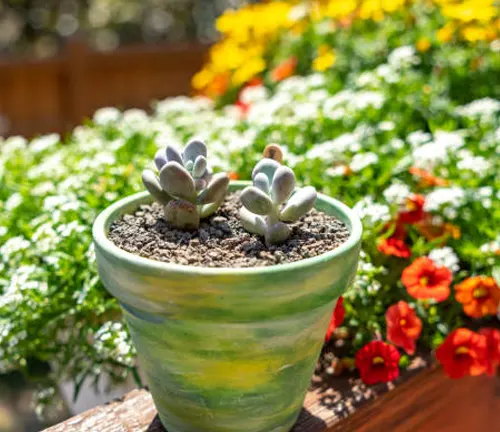
Planting and Care:
- Best Time to Plant: Spring, which will give it ample time to establish before the cooler months.
- Watering: Moderate watering needed; allow the soil to dry out completely between sessions.
- Light: Bright, indirect light enhances leaf coloration without causing sunburn.
- Soil: Use a succulent mix with perlite or pumice added for increased drainage.
- Temperature: Ideal temperatures are between 60°F to 80°F (16°C to 27°C). Avoid cold drafts and frost.
- Additional Care: Moonstones are sensitive to overwatering which can cause root rot. Ensure the pot has good drainage holes.
18. Xerographica (Tillandsia Xerographica)
Tillandsia Xerographica, commonly known as the King of Air Plants, stands out for its large, majestic silver curls that make it highly ornamental. This air plant doesn’t require soil to grow, absorbing moisture and nutrients through its leaves from the air. Xerographica is an excellent choice for modern, soil-free garden designs.
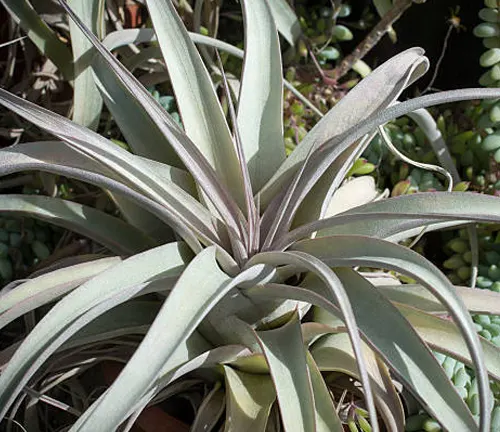
Planting and Care:
- Best Time to Plant: Any time of year, as it doesn’t require traditional planting.
- Watering: Submerge in water for 2-3 hours every two weeks.
- Light: Bright, indirect light or filtered sunlight.
- Soil: No soil needed; can be mounted on almost any surface like wood or rocks.
- Temperature: Prefers warmer climates but should be kept away from extreme heat.
- Additional Care: Shake off excess water after soaking to prevent rot. Fertilize sparingly with a bromeliad or orchid fertilizer.
Care and Maintenance Tips
Proper care is essential for maintaining healthy succulents. They are generally low-maintenance, but their needs can vary significantly between different types. Understanding these can prevent common issues and help your plants thrive.
General Care Guidelines
- Watering Techniques: Succulents prefer the “soak and dry” method. Fully saturate the soil when you water, then let it dry completely before watering again. This prevents root rot and mimics their natural arid environment.
- Light Requirements: Provide at least six hours of indirect sunlight per day. Rotate succulents periodically to ensure all sides receive light, preventing lopsided growth.
- Soil and Potting: Use a well-draining cactus or succulent mix to enhance drainage. Ensure pots have drainage holes to avoid water accumulation.
- Fertilization Practices: During the growing season (spring to summer), feed succulents with a half-strength balanced fertilizer every month. Avoid fertilizing in the dormant winter months.
Troubleshooting Common Problems
Understanding and identifying issues early makes management much easier:
- Overwatering: Symptoms include yellowing and soft, mushy leaves. Reduce watering and ensure your pot and soil allow for adequate drainage.
- Underwatering: Shriveled, dry leaves indicate a need for more water. Adjust your watering schedule, especially during hot, dry periods.
- Pests: Mealybugs, spider mites, and fungal gnats are common. Treat infestations with insecticidal soap or neem oil, applying it directly to the affected areas.
- Sunburn: If leaves discolor (typically turning white and crispy), move the plant out of direct sunlight to prevent further damage.
Styling with Succulents
Succulents offer stylish versatility and modern aesthetics for home decor. Their varied forms and colors make them excellent for creative arrangements.
Design Ideas for Indoor Arrangements
Create dynamic and visually appealing indoor displays:
- Mixed Plantings: Combine different succulent species in one pot to achieve a textured, vibrant look. Vary the plant heights and colors for maximum effect.
- Creative Containers: Use unconventional planters like wall mounts, teacups, or repurposed items to add character. Ensure they have proper drainage.
- Placement Tips: Succulents do well on windowsills, desks, or any bright area. They are excellent for filling underutilized spaces with life and color.
Seasonal Care and Display Tips
Adjust care with the seasons and utilize succulents in your festive decor:
- Watering and Light: Reduce watering in winter. If natural light is low, consider using a grow light to supplement sunlight.
- Decorative Uses: During holidays, decorate succulents with festive ornaments or incorporate them into wreaths and centerpieces. They make excellent, low-maintenance seasonal displays.
Related Post
- How to Fertilize a Mango Tree Effectively: Tips and Tricks for Healthy Growth
- How to Fertilize Apple Trees: Essential Tips for a Bountiful Harvest
- How to Fertilize Lemon Trees: Secrets for Thriving Citrus
- How to Fertilize Avocado Tree: A Step-by-Step Guide for Lush Growth
- How to Fertilize Bougainvillea: A Complete Guide for Stunning Blooms
Conclusion
Succulents are ideal for enhancing indoor environments due to their beauty, diversity, and easy care nature. By adhering to these care guidelines and embracing their versatility in home decor, you can enjoy these charming plants year-round. Whether you are a seasoned gardener or a beginner, succulents can make a great addition to your home, providing a splash of color and nature to your living space.
FAQs
- Can succulents improve indoor air quality?
Yes, they absorb toxins like benzene and release oxygen at night, which enhances air quality and can help improve sleep. - What are some unique succulent colors to look for in 2024?
Look for succulents in deep purples, bright blues, and near-black tones, such as ‘Black Prince’ Echeveria and Sedum ‘Blue Feather’. - How often should I rotate my succulents?
Rotate succulents once a week to ensure even light exposure, prevent lopsided growth, and maintain symmetry. - Are there any edible succulents?
Yes, the Opuntia (Prickly Pear) cactus pads are edible, and Aloe Vera sap can be used in drinks, but with moderation due to its laxative properties. - What is the best way to display succulents for aesthetic impact?
Use arrangements of varying heights, colors, and textures. Combine trailing succulents like String of Pearls with rosette types such as Echeveria for dynamic displays. - Can succulents thrive under artificial lighting?
Yes, particularly under LED grow lights. Keep lights on for about 12-14 hours daily to best mimic natural sunlight conditions. - What are the signs of too much sunlight on succulents?
White or brown burn marks, faded or bleached areas, and crispy dry leaves are signs of too much direct sunlight. - How do I choose the right soil for succulents? Can I make my own mix?
Use a well-draining cactus mix or make your own by combining potting soil, coarse sand, and perlite in a 1:1:1 ratio to ensure proper drainage.
Explore the beauty and simplicity of succulents with our top 18 picks for 2024. These easy-to-care-for plants are perfect for adding a touch of effortless elegance to any home. Start your succulent garden and enjoy vibrant greenery all year round. Happy planting!

Kristine Moore
Forestry AuthorI'm Kristine Moore, a seasoned garden landscaping professional with over 30 years of experience. My extensive career has been dedicated to transforming outdoor spaces into stunning, sustainable landscapes. With a deep understanding of horticulture, design principles, and environmental stewardship, I have become a respected figure in the field, known for creating harmonious, visually appealing, and eco-friendly gardens. My commitment to excellence and continuous learning in landscaping trends and techniques has solidified my reputation as an expert in garden design and implementation.













Leave your comment